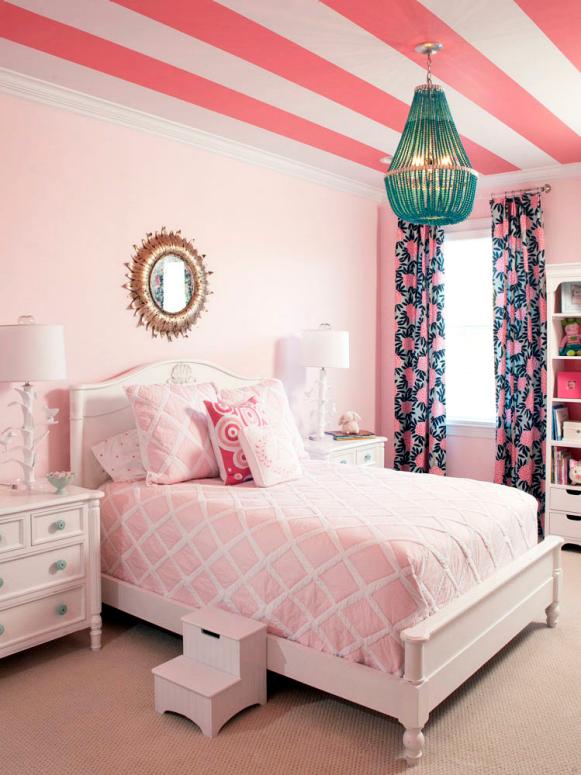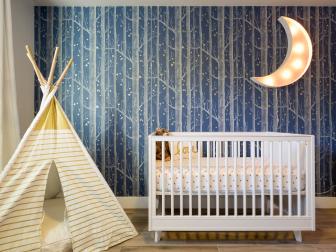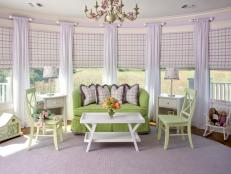Lighting for Kids' Rooms

Lighting is possibly the most overlooked element in any room’s design — and also one of the most important, particularly in a multifunctional space like a child's room.
3 Basic Types of Lighting
Ambient lighting creates a pleasing overall glow. Overhead fixtures, both ceiling-mounted and recessed, provide ambient light.
Task lighting illuminates specific activities such as homework or reading. Sconces and lamps offer task lighting.
Accent lighting highlights architectural and design elements. A recessed ceiling fixture positioned to shine on a favorite piece of artwork is an example of accent lighting.
When designing a kid's bedroom lighting, think about the activities that take place in the room. Does your child read in bed? Does she build with blocks or construct models? Does he do art or study in his bedroom? You'll want to take these activities into consideration and remember to include ambient and task lighting. Accent lighting is the icing on the cake, the element that makes all the hard work you put into choosing the right wall hangings, hand-painted murals, showstopping window treatments and more shine through.
25 Lighting Ideas for Your Kids' Room 25 Photos
Brighten the cutest space in the house with our favorite nightlights, neon signs, pendants and more.
Plan for Safety
You'll need to think about safety as you choose your lighting fixtures and lamps. Designer and mother of boys Terry Ervin advises, "go with lighting that isn't breakable — wood lamps, not glass or pottery. And recessed lighting is safer than ceiling or wall fixtures that can be hit with balls and paper airplanes. Be attuned to things that could fly through the air."
Try to imagine what a curious toddler might topple. "Babies can easily pull floor lamps over," says Pam Ginocchio, co-founder of Project Nursery. "Be sure to secure lamp cords to the leg of a table, or to the wall."
Many children, particularly toddlers and preschoolers, feel more secure if there is a nightlight installed in their bedroom to ensure that if they wake up in the middle of the night, it isn't pitch dark. Nightlights are available in a range of styles and sizes, from licensed characters to night lights that play music. A small plug-in emergency light will provide light both at night and if the power goes out, a blessing during stormy nights if your child wakes up.

Design Options
When you're ready to shop, remember that lamps and lighting fixtures can be strong decorative elements.
"Don't go too small," says Susanna Salk, designer and author of Room for Children. "People tend to think tiny for a child's room, but bold, chunky lamps — especially in pairs, like on each end of a dresser — look really great."
And, remember function. "Reading lights should be adjustable," says Nancy Barrett, designer of Decorating Den Interiors. "So you can direct the beam right where you need it. And, three-way lamps, which have three levels of illumination controlled at the switch, are great. Even better: Install dimmers at all your wall switches."
The lampshade you choose is another important decision, and an opportunity to personalize your lamp. "I love to buy inexpensive lamps and have the kids decorate the lampshade with trim, tassels, paint or decoupage. It's an easy way to get them involved in the design," says Barbara Tabak, designer of Decorating Den Interiors.
It's also a good idea to keep the future in mind when lighting a kids' room. If you choose fixtures that are appropriate for a boy or girl at a wide age range, you won't have to replace them as often. Develop a lighting plan that will still be compatible with your child's tastes as he or she matures. While table and floor lamps can easily be changed, you can save money over time by taking the long view.
Instead of buying lamps in the shape of a licensed cartoon character, which children quickly outgrow, consider their interests. Art, sports and other games and nature themes can all evolve as your child grows. Don't be bound by gender stereotypes, particularly with regard to color. Many girls like shades of blue and green, and a boy's room can be every bit a boy's room with red, yellow, purple and other bright hues. Let your child's individual tastes shine through.





































